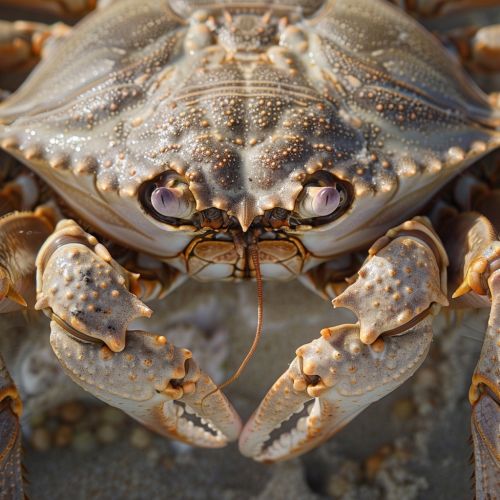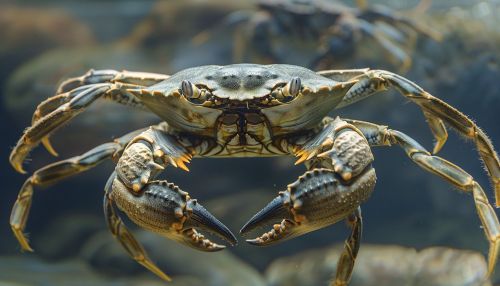Crab
Introduction
Crabs are a diverse group of aquatic animals that belong to the decapod order of the crustacean family. They are characterized by their hard exoskeleton, two claws or chelae, and four pairs of legs. Crabs are found in all of the world's oceans, as well as in fresh water and on land. There are over 7,000 known species of crabs, each with its own unique characteristics and adaptations.


Anatomy and Morphology
Crabs have a thick exoskeleton made of chitin and calcium carbonate, which provides protection from predators and supports their body. The exoskeleton is periodically shed in a process called moulting, which allows the crab to grow. The crab's body is divided into two main parts: the cephalothorax (the head and thorax fused together) and the abdomen.
The cephalothorax is covered by a carapace, a large shell that protects the internal organs and the gills. The front of the cephalothorax features a pair of compound eyes on stalks, which provide a wide field of vision, and two pairs of antennae. The first pair of antennae, or antennules, are used for sensing the environment, while the second pair of antennae are used for touch and taste.
The abdomen of the crab is significantly smaller than the cephalothorax and is usually tucked under the body. In most species, the abdomen is segmented and flexible, allowing for movement and the carrying of eggs in female crabs. The abdomen ends in a tail fan, which is used for swimming in some species of crabs.
Crabs have ten legs, the first pair of which are modified into claws or chelae. These claws are used for a variety of purposes, such as defense, feeding, and courtship rituals. The remaining legs are used for locomotion and, in some species, for digging or climbing.
Behavior and Ecology
Crabs are highly adaptable creatures and can be found in a variety of environments, from the deep sea to freshwater rivers and streams, and even on land. They are generally covered in tiny hair-like structures called setae that are sensitive to changes in their environment, such as temperature and salinity.
Crabs are primarily carnivorous, feeding on a diet of algae, mollusks, bacteria, other crustaceans, and small fish. However, some species are omnivorous or even herbivorous. Crabs use their sharp claws to capture and manipulate their food.
Crabs exhibit a range of behaviors, including burrowing, climbing, and even swimming. Some species are solitary, while others live in large groups. Crabs communicate through a variety of means, including visual signals, touch, and chemical signals.
Crabs play a crucial role in the ecosystem, serving as both predators and prey. They help to control the populations of their prey species, and their eggs and larvae provide a valuable food source for a variety of marine animals.
Reproduction and Lifecycle
Crabs have a complex lifecycle that includes several stages. Most crabs begin life as tiny, free-swimming larvae called zoea. After several moults, the zoea transforms into a megalopa, which more closely resembles an adult crab. The megalopa eventually settles to the seafloor and metamorphoses into a juvenile crab.
Reproduction in crabs typically involves internal fertilization. In many species, the male transfers sperm to the female through a modified pair of appendages called gonopods. The female then lays thousands to millions of eggs, which she carries on her abdomen until they hatch.
Human Interaction
Crabs have a long history of interaction with humans. They are a popular food source in many cultures, and crab fishing is a significant industry in many parts of the world. Some species of crabs are also kept as pets or used in research.
However, human activities have also posed challenges to crab populations. Overfishing, habitat destruction, and climate change are all threats to many species of crabs.
